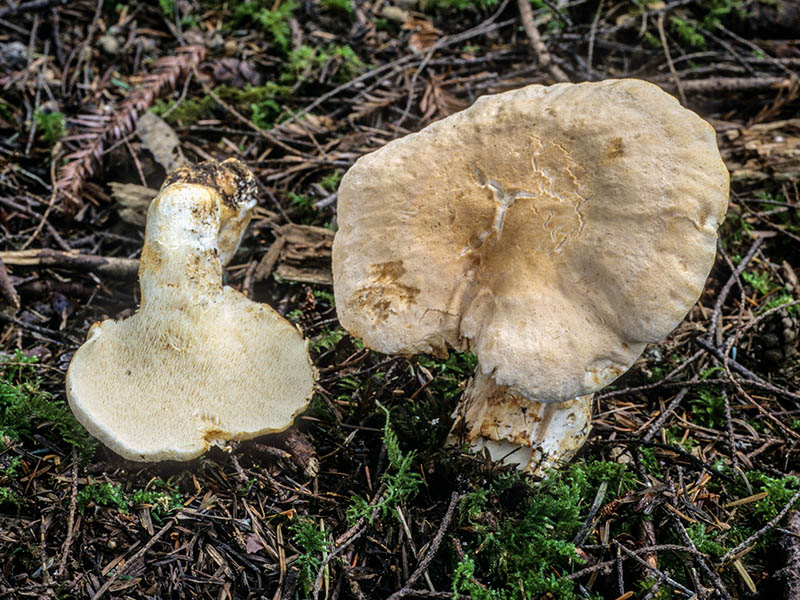Hydnum repandum
Syst. mycol. 1: 400. 1821.
Common Name: hedgehog
Synonym: Dentinum repandum (L. : Fr.) S. F. Gray
-
Pileus
Cap 2-12 cm broad, convex, becoming nearly plane, disc sometimes depressed; margin inrolled at first, lobed to undulate; surface dry, smooth to slightly scaly, cream to buff-orange, bruising to orange-brown; flesh thick, pale-buff, brittle, bruising buff-orange; odor and taste mild.
-
Hymenophore
Teeth 0.4-0.6 cm long, brittle, cream-colored, bruising orange-brown, sometimes decurrent.
-
Stipe
Stipe 2-7 cm tall, 1-2.5 cm thick, equal to enlarged at the base; attachment central to eccentric; surface dry, smooth, cream to buff-yellow, bruising orange-brown; veil absent.
-
Spores
Spores 6.5-8.5 x 6-8 µm, nearly round, smooth. Spore print white.
-
Habitat
Scattered to gregarious under conifers, occasionally with hardwoods; in our area common under Bishop pine (Pinus muricata) and Douglas fir (Pseudotsuga menziesii). Fruiting from mid-winter to early spring.
-
Edibility
 Edible and excellent, although they can be bitter unless well cooked.
Edible and excellent, although they can be bitter unless well cooked. -
Comments
Hydnum repandum fruits late in the mushroom season, often not until after the New Year. Its pale-buff to buff-orange fruiting body resembles Cantharellus californicus or C. formosus, but the latter are yellower in color, has ridges, not spines on the lower cap surface and generally grows with hardwoods like Quercus agrifolia, not conifers. Hydnum umbilicatum is a closely related species, smaller in size, the cap having a small, central pit.
The true Hydnum repandum is not known to occur in California. There are 2-3 species hiding under this name, more research is needed to clarify this situation.
-
References
Arora, D. (1986). Mushrooms Demystified. Ten Speed Press: Berkeley, CA. 959 p.
Breitenbach, J. & Kränzlin, F. (1986). Fungi of Switzerland. Volume 2: Non-Gilled Fungi. Verlag Mykologia: Luzern, Switzerland. 412 p.
Coker, W.C. & Beers, A.H. (1951). The Stipitate Hydnums of the Eastern United States. The University of North Carolina Press: Chapel Hill, NC. 211 p.
Desjardin, D.E., Wood, M.G. & Stevens, F.A. (2015). California Mushrooms: The Comprehensive Identification Guide. Timber Press: Portland, OR. 560 p.
Ellis, M.B. & Ellis, J.P. (1990). Fungi without Gills (Hymenomycetes and Gasteromycetes). Chapman and Hall: London, England. 329 p.
Hall, D. & Stuntz, D.E. (1971). Pileate Hydnaceae of the Puget Sound Area. I. White-Spored Genera: Auriscalpium, Hericium, Dentinum and Phellodon. Mycologia 63(6): 1099-1128. (PDF)
Mass Geesteranus, R.A. (1971). Hydnaceous Fungi of the Eastern Old World. North Holland Publishing Company: Amsterdam, Netherland. 175 p.
Pegler, D.N., Roberts, P.J. & Spooner, B.M. (1997). British Chanterelles and Tooth Fungi. Royal Botanic Gardens: Kew, England. 114 p.
Siegel, N. & Schwarz, C. (2016). Mushrooms of the Redwood Coast. Ten Speed Press: Berkeley, CA. 601 p.
Smith, A.H. (1949). Mushrooms in their Natural Habitats. Sawyer's Inc: Portland, OR. 626 p. (PDF) -
Other Descriptions and Photos
- Fred Stevens: Hydnum repandum (CP)

- Boleslaw Kuznik: Hydnum repandum (CP)

- Dimitar Bojantchev: Hydnum repandum (CP)

- Dimitar Bojantchev: Hydnum repandum (CP)
- Douglas Smith: Hydnum repandum (CP)

- Darvin DeShazer: Hydnum repandum (CP)

- Taylor F. Lockwood: Hydnum repandum (CP) — closeup of the hymemophore ("teeth")
- Mushroom Observer: Hydnum repandum (CP)
- MushroomExpert.com: Hydnum repandum (D & CP)
- Wikipedia: Hydnum repandum (D & CP)
- Rogers Mushrooms: Hydnum repandum (D & CP)
- Pilzgalerie.de: Hydnum repandum (CP)
- Pilze, Pilze, Pilze: Hydnum repandum (CP)
- Arora (1986): p. 618 (D), plates 161, 162 (CP) [as Dentinum repandum]
- Arora (1991): p. 203 (D & CP)
- Fischer & Bessette: p. 108 (D & CP)
- Jordan: p. 87 (D & CP)
- Lincoff: p. 428 (D), plate 455 (CP) [as Dentinum repandum]
- McKenny et al.: p. 171 (D), p. 172 (CP)
- Miller: sp. 336 (D & CP) [as Dentinum repandum]
- Phillips: p. 273 (D & CP)
- Smith: sp. 27 (D & CP) [as Dentinum repandum]
- Smith & Weber: sp. 40 (D & CP) [as Dentinum repandum]
- Fred Stevens: Hydnum repandum (CP)
